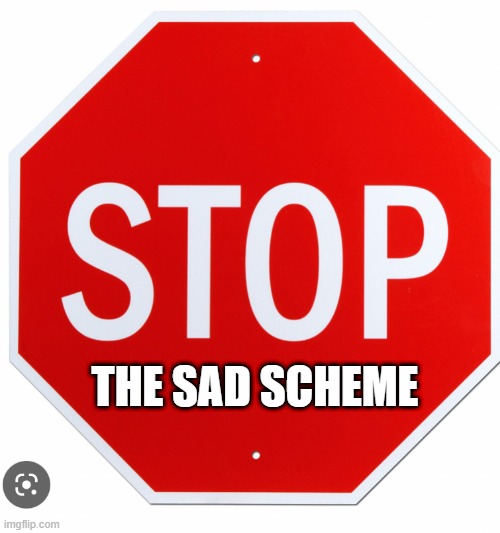SAD Scheme Cases Are Always Troubling–Betty’s Best v. Schedule A Defendants 😠
 Every SAD Scheme lawsuit is problematic, though the specific reasons may differ. Each lawsuit creates dozens or hundreds of individual dramas, few of which receive any public scrutiny, and usually comes at the cost of due process and the rule of law. Thus, I feel a little weird blogging each SAD Scheme case, because it might imply that the covered case deserves more criticism than thousands of others like it. So this blog post isn’t about a particularly unusual or egregious SAD Scheme case. It’s just today’s exemplar.
Every SAD Scheme lawsuit is problematic, though the specific reasons may differ. Each lawsuit creates dozens or hundreds of individual dramas, few of which receive any public scrutiny, and usually comes at the cost of due process and the rule of law. Thus, I feel a little weird blogging each SAD Scheme case, because it might imply that the covered case deserves more criticism than thousands of others like it. So this blog post isn’t about a particularly unusual or egregious SAD Scheme case. It’s just today’s exemplar.
Betty’s Best makes “the StripHair Gentle Groomer, a therapeutic brush for horses and dogs.” Some details about its lawsuit:
- Betty’s Best sued 1,099 defendants in a single complaint. As usual, the Schedule A provides threadbare information about each defendant. It lists only the marketplace, merchant name, and seller ID.
- Why did Betty’s Best name “only” 1,099 defendants on this one complaint? Why not 10,000? 1M?
- The complaint’s filing fee was $402, so Betty’s Best paid 37 cents per defendant to file the lawsuit.
- I’m going to go out on a limb and say that there is no possible way that all 1,099 defendants were properly joined. As another court explained, “Distinct individuals or entities independently selling counterfeit goods over the internet does not satisfy the transaction or occurrence requirement of FRCP 20.6.” Ontel Prods. Corp. v. Uninc. Ass’ns Identified in Schedule A, No. 1:21cv1452 (MSN/JFA), 2022 WL 9874815, at *5 (E.D. Va. Aug. 12, 2022).
- The likely misjoinder costs taxpayers a lot of money. Independent lawsuits against 1,099 defendants would cost $440,000+ in filing fees. Betty’s Best paid $402. So, taxpayers may be providing close to a half-million dollar subsidy to fund this one lawsuit.
- 64 defendants banded together and fought back with legal representation. This is unusual because few SAD Scheme defendants can afford a lawyer or coordinate their actions.
- Among those 64 defendants, the ex parte TRO caused $21M of their assets to be frozen.
- I wonder about how $21M of asset freezes compares to the total global market size for the specific products at issue.
- It doesn’t appear that Betty’s Best provided any evidence to justify the amount of $21M in asset freezes as an appropriate remedy, temporary or not. If Betty’s Best didn’t anticipate that its actions would have such a sizable effect, then its remedial request was underresearched and its risks were inadequately explained to the judge.
- The 64 defendants introduced evidence that their total sales of the allegedly infringing items was $42k. They later walked this number back and said they don’t know the number.
- The court reduced the asset freeze from $21M to $2M. That partially fixes the court’s initial error. However, the court’s attitude about the $19M overreach with the initial asset freeze apparently is ¯\_(ツ)_/¯. I didn’t see any consequences imposed on Betty’s Best for that overreach.
- The magistrate granted a preliminary injunction against the 64 defendants. As usual, the supervising judge affirmed without substantive comment. Only 1,035 defendants more to address.
To recap: Betty’s Best sued over a thousand defendants in a single lawsuit, many of whom are likely unrelated, and doing so cost the government hundreds of thousands of dollars of filing fees. Betty’s Best then overrestrained no less than $19M of defendants’ assets without sanctions. As Paul McCartney might sing, 🎶 “Take a SAD Scheme and make Betty’s better.” 🎶 #StopTheSADScheme.
Case citation: Betty’s Best, Inc. v. Schedule A Defendants, 2023 WL 8310347 (S.D. Fla. Nov. 17, 2023). The supervising judge approved the magistrate’s recommended preliminary injunction on December 4.
BONUS: Luke Combs discovered that his enforcement team ruined a fan’s life using the SAD Scheme.
Prior Blog Posts on the SAD Scheme
- Judge Pushes Back on SAD Scheme Sealing Requests
- Roblox Sanctioned for SAD Scheme Abuse–Roblox v. Schedule A Defendants
- Now Available: the Published Version of My SAD Scheme Article
- In a SAD Scheme Case, Court Rejects Injunction Over “Emoji” Trademark
- Schedule A (SAD Scheme) Plaintiff Sanctioned for “Fraud on the Court”–Xped v. Respect the Look
- My Comments to the USPTO About the SAD Scheme and Anticounterfeiting/Antipiracy Efforts
- My New Article on Abusive “Schedule A” IP Lawsuits Will Likely Leave You Angry
- If the Word “Emoji” is a Protectable Trademark, What Happens Next?–Emoji GmbH v. Schedule A Defendants
- My Declaration Identifying Emoji Co. GmbH as a Possible Trademark Troll

